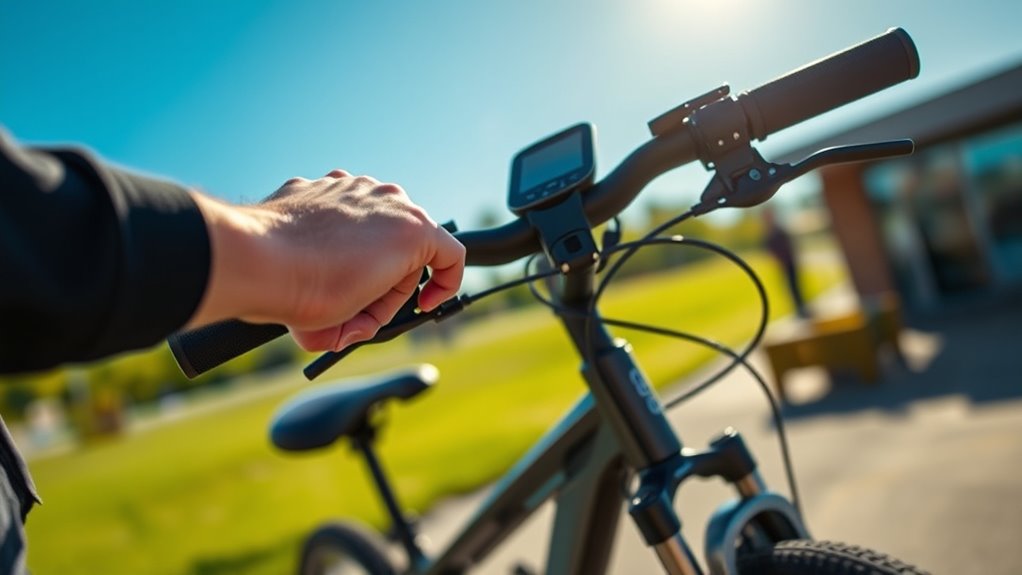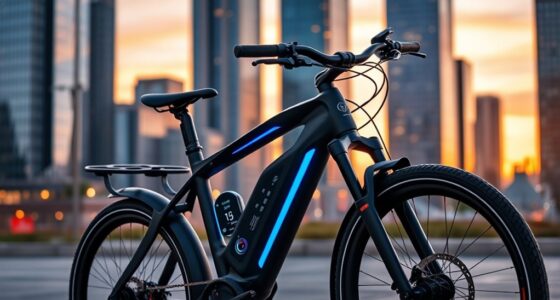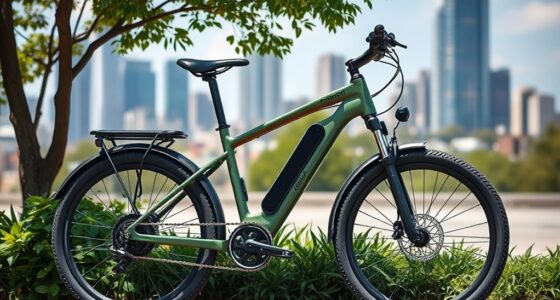When buying a used e-bike, start by thoroughly inspecting its condition, checking for rust, cracks, and tire wear. Test the battery and motor for responsiveness and proper charge retention. Review maintenance records and ask about past repairs or accidents. Take a test ride to identify any handling or noise issues. Verify the bike’s ownership details and registration to guarantee it’s legit. To uncover more expert tips, explore what professionals recommend for a safe purchase.
Key Takeaways
- Conduct a thorough physical inspection for frame damage, rust, and tire wear to ensure structural integrity.
- Request the manufacturer’s report or perform a test ride to assess battery health and motor responsiveness.
- Review maintenance history and inquire about past accidents, repairs, and usage patterns for reliability insights.
- Test the e-bike on various surfaces to check handling, braking, and overall performance before buying.
- Verify legal documentation, ownership transfer, and cross-check serial numbers to ensure authenticity and compliance.
Inspect the Bike’s Physical Condition

Before purchasing a used e-bike, you should thoroughly inspect its physical condition to guarantee it’s in good shape. Start by checking the frame integrity; look for cracks, dents, or signs of rust that could compromise the bike’s stability. A sturdy frame ensures safety and longevity. Next, examine the tires for wear. Uneven or excessive tire wear might indicate misalignment or suspension issues, which can lead to poor handling. Spin the wheels to see if they wobble or make unusual noises. Ensure the tires have enough tread and are properly inflated. Don’t forget to look for any signs of corrosion or damage on other components. A careful physical inspection helps you identify potential problems before making a purchase, saving you money and ensuring a safe ride.
Verify the Battery and Motor Performance

To guarantee the used e-bike performs reliably, you need to verify that its battery and motor are functioning properly. Check the battery health by asking for the manufacturer’s report or performing a test ride to see how quickly the battery drains and how well it retains charge. A healthy battery should hold charge well and not drain prematurely. For the motor, test its efficiency by accelerating gradually and noting any unusual noises or vibrations. Ensure the motor provides smooth power without hesitation or loss of responsiveness. Observe how the motor performs under load, such as riding uphill. If possible, have a professional inspect the battery and motor to confirm they’re in good condition, giving you confidence in the e-bike’s reliability and performance. Additionally, understanding AI in Business can help you analyze and interpret data related to e-bike performance metrics for better maintenance decisions.
Review the Bike’s Maintenance and Usage History

Checking the bike’s maintenance and usage history gives you insight into how well it’s been cared for and how it’s performed over time. Review records for signs of regular upkeep, such as tire replacements or brake servicing. Ask about any past accidents or repairs that might affect the bike’s reliability. Confirm the bike’s insurance status to ensure it’s properly covered. Check accessories compatibility to see if the bike has been modified or upgraded appropriately. Look for consistent usage patterns that match your riding style, and verify if any major components have been replaced recently. Understanding these details helps you assess the bike’s overall condition and longevity, reducing surprises later. A well-documented history indicates responsible ownership and can save you money and hassle down the line. Additionally, paying attention to electronic components and their wear can provide further insight into the bike’s overall health.
Test Ride and Check for Issues

Taking the bike for a test ride is essential to identify any immediate issues and assess how it feels in real-world conditions. Pay close attention to the bike frame integrity—look for cracks, dents, or unusual noises that might indicate damage. During the ride, check how smoothly the motor engages and whether the brakes respond effectively. Examine the tire tread condition; worn or uneven tread can signal poor maintenance or upcoming replacement needs. Test the bike at different speeds and on various surfaces to spot any wobbling or handling problems. Listen for any strange sounds from the motor or drivetrain. A thorough test ride helps you spot issues early, ensuring you’re making a safe, informed purchase. Additionally, inspecting the battery life and charging port can prevent surprises after purchase.
Confirm Legal and Ownership Details

Before finalizing your purchase, it’s important to verify that the bike’s legal and ownership details are in order. This ensures you’re protected and avoids future issues. Check these key items:
Before buying, verify the bike’s legal papers and ownership to ensure smooth transfer and legal safety.
- Legal documentation: Confirm the seller has the original purchase receipt, registration papers, and any applicable permits.
- Ownership transfer: Make sure the seller can legally transfer ownership and that the title is clear of liens or disputes.
- Serial number verification: Cross-check the bike’s serial number with official records to confirm authenticity.
- Seller legitimacy: Verify the seller’s identity and ensure they’re authorized to sell the e-bike, preventing fraud.
- Market research: Conduct research on current regulations and private placement practices related to e-bike sales to ensure compliance and informed decisions.
Verifying these details ensures a smooth ownership transfer and legal compliance, giving you peace of mind.
Frequently Asked Questions
How Can I Identify a Stolen E-Bike?
To identify a stolen e-bike, start by inspecting its frame for signs of tampering or inconsistent markings. Check the bike’s serial number against official records or registration databases to confirm ownership. Be cautious if the seller hesitates to provide proof of purchase. Recognizing stolen bikes involves being aware of common theft signs and practicing bike theft prevention, such as verifying serial numbers and avoiding suspiciously cheap deals.
What Warranties Are Typically Available for Used E-Bikes?
When buying a used e-bike, you should check what warranties are available. Many sellers offer limited motor warranties that cover the motor for a certain period, giving you peace of mind. Also, inquire about the battery life warranty, which guarantees the battery’s performance over time. Knowing these warranties helps protect your investment and ensures you get a reliable e-bike, especially if issues arise after purchase.
Are There Specific Brands More Reliable for Used E-Bikes?
When choosing a used e-bike, you should consider brand reputation and model reviews to guarantee reliability. Some brands are known for durability and quality, making them safer bets. Do your research on specific models, reading reviews from other riders to identify common issues or strengths. By focusing on trusted brands with positive feedback, you can confidently select a used e-bike that will serve you well and last longer.
How Do I Determine the Fair Market Value of a Used E-Bike?
Did you know that used e-bikes can lose up to 20% of their value within the first year? To determine a fair market value, you should consult pricing guides and do thorough market research. Check online listings, local shops, and compare models with similar features and condition. This helps you understand current market trends, ensuring you pay a reasonable price and avoid overpaying for a used e-bike.
What Accessories or Upgrades Should I Consider When Buying Used?
When buying a used e-bike, consider accessories and upgrades that enhance safety and performance. Prioritize helmet safety by ensuring it fits well and is in good condition. Check if the tires need upgrades for better grip or durability, especially if you plan to ride on different terrains. Upgrading to puncture-resistant tires or adding lights can also improve safety. These upgrades make your ride safer and more enjoyable right from the start.
Conclusion
By following these tips, you’ll dodge costly mistakes and avoid ending up with a lemon that leaves you stranded miles from home. Imagine investing your hard-earned cash into a used e-bike only to find it’s a ticking time bomb, ready to break down at the worst moment. Don’t let that happen to you! Take these steps seriously, and you’ll ride with confidence, knowing you’ve made the smartest, safest purchase possible—your perfect e-bike awaits!









